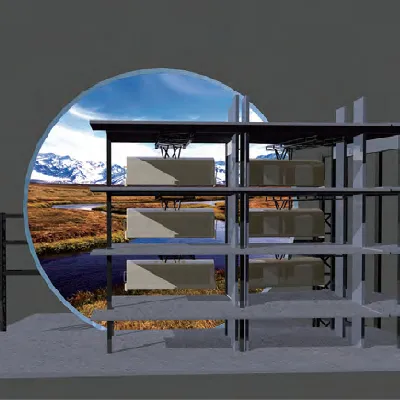- Albanian
- Arabic
- Belarusian
- Bengali
- Czech
- English
- French
- German
- Hebrew
- Hungarian
- Indonesian
- irish
- Italian
- Japanese
- kazakh
- Persian
- Russian
- Thai
- Uzbek
- Vietnamese
basic roller coaster design
Basic Roller Coaster Design Principles and Features
Roller coasters have long been a cornerstone of amusement parks, thrilling riders with their exhilarating speeds, lofty heights, and hair-raising drops. The design of a roller coaster is a complex process that combines physics, engineering, and creativity to create a ride that is safe, exciting, and visually appealing. This article delves into the basic principles of roller coaster design, focusing on key elements that make these rides so popular.
Understanding Kinematics and Forces
At the heart of roller coaster design is a solid understanding of physics, particularly kinematics and the forces that affect a moving body. The thrill of a roller coaster ride comes from the interplay of gravitational forces, inertia, and centripetal force. Key terms include acceleration, velocity, and g-forces, all of which must be carefully calculated to ensure a safe and enjoyable experience for riders.
1. Gravity Gravity is the primary force driving a roller coaster. The initial drop is often the highest point of the ride, where potential energy transforms into kinetic energy as the coaster descends. Designers utilize this conversion of energy to create thrilling drops and high speeds.
2. G-Forces G-forces measure the amount of acceleration felt by riders. Roller coasters are designed to deliver a range of g-forces, some creating a sensation of weightlessness (negative g-forces) while others push riders into their seats (positive g-forces). Designers must balance these forces to achieve an exhilarating ride without exceeding safety limits.
Designing the Track
The design of the track is where creativity and engineering intersect. Roller coasters can come in several styles, such as wooden, steel, or hybrid designs, each offering unique ride experiences. The layout includes a combination of loops, twists, turns, and drops, which must be precisely engineered to ensure the ride operates smoothly and safely.
1. Initial Lift Hill Most roller coasters start with a lift hill, where the train is elevated using a chain lifter. This is a crucial element, as it sets the stage for the ride's exhilarating descent. The height of the lift hill greatly influences the potential energy available for the rest of the ride.
basic roller coaster design

2. Elements of Excitement Key elements such as vertical loops, corkscrews, and airtime hills are designed to enhance the thrill factor. Each element must be carefully calculated to make sure that riders experience excitement without compromising safety.
3. Braking Systems An efficient braking system is fundamental to roller coaster design. Brakes need to be strategically placed to slow down the train safely at the end of the ride, as well as to manage speed during the course. This ensures that riders can exit comfortably after their adventure.
Safety Considerations
Safety is the foremost priority in roller coaster design. Every aspect of the ride, from the structural integrity of the track to the restraints used to secure riders, must be meticulously planned and tested. Engineers conduct extensive simulations and models to anticipate potential issues and ensure the ride adheres to industry safety standards.
1. Restraints and Harnesses The designs of seat belts, lap bars, and over-the-shoulder restraints vary according to the type of coaster. The aim is to keep riders secure while still allowing freedom of movement, thus enhancing the thrill of the ride.
2. Material Selection The choice of materials—whether wood, steel, or composite—affects both the ride's experience and safety. Steel coasters often allow for more intricate designs and smoother rides, while wooden coasters provide a classic, rugged feel.
3. Regular Maintenance Maintenance protocols are critical in keeping roller coasters safe for operation. Inspectors regularly assess tracks, trains, and safety systems to prevent malfunctions. This oversight is essential for building trust with riders and ensuring enjoyable experiences.
Conclusion
The design of a roller coaster is a fascinating blend of art and science, requiring careful consideration of physical laws, safety protocols, and rider experience. As technology continues to advance, roller coasters evolve, offering more immersive and breathtaking experiences. From the exhilarating drops to the thrilling loops, a thoughtfully designed roller coaster delivers not just a ride, but an unforgettable adventure that keeps people coming back for more.
-
Flume Ride-Hebei Zhipao Amusement Equipment Manufacturing Co., Ltd.|Thrilling Water Attraction&NIST Safety StandardsAug.01,2025
-
Double Ferris Wheel Sale | Premium Custom RidesJul.31,2025
-
Flume Ride-Hebei Zhipao|Water-Based Attraction, Safety Standards, High-Speed DescentJul.31,2025
-
Flume Ride: Thrilling Water-Based Adventure & Advanced Engineering - Hebei ZhipaoJul.31,2025
-
Flume Ride-Hebei Zhipao Amusement Equipment Manufacturing Co., Ltd.|Thrilling Water Attraction&Customizable DesignJul.30,2025
-
Flume Ride - Hebei Zhipao Amusement Equipment | Water Coaster, Thrilling DescentJul.30,2025
